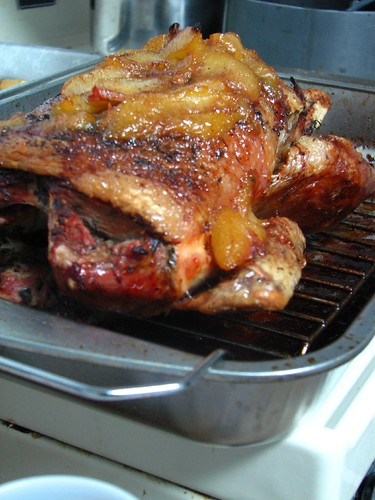Roasted duck a la pluot with roasted purple and fingerling potatoes and soy glazed long beans.
Sounds fancy, but tasted fantastic. The kids helped with all of the prep and they were talking about this wonderful meal for days to come.
 First we "brined" the duck by giving it a salt water bath while we did all the prep. Then we picked the thyme and marjoram from the stem, a perfect job for little 6 year old fingers, as was cutting the tips off of the long beans.
First we "brined" the duck by giving it a salt water bath while we did all the prep. Then we picked the thyme and marjoram from the stem, a perfect job for little 6 year old fingers, as was cutting the tips off of the long beans. Next we sliced the potatoes into 1" in pieces, something you can definitely trust a 13 year old to do. He also peeled and smashed a couple cloves of garlic (OK more like 6) and peeled and quartered pearl onions. While the kids took care of that portion of the meal, I peeled the pluots (a cross between a plum and an apricot) and put them in a pot with ginger, cinnamon, allspice and touch of turbinado sugar. A lot of spices, but I used a very light hand for each of them.
 Now we didn't actually COOK anything up to this point because we had to go get our three year old from daycare. So once we got back, I rinsed the duck, seasoned it with the herbs by sticking them under the skin next to the meat, filled the cavity with a lemon, some garlic cloves and hit the entire bird with fresh black pepper and popped that bad boy in the oven (no need to salt it as it'd been in a salt bath for 3 hours).
Now we didn't actually COOK anything up to this point because we had to go get our three year old from daycare. So once we got back, I rinsed the duck, seasoned it with the herbs by sticking them under the skin next to the meat, filled the cavity with a lemon, some garlic cloves and hit the entire bird with fresh black pepper and popped that bad boy in the oven (no need to salt it as it'd been in a salt bath for 3 hours). Next the potatoes were dressed with a little olive oil, salt pepper and the last of the herbs and they went in after the duck had been in the oven about 30 minutes.
Finally I turned on the pot with the pluots so they could cook down, and heated a large pot of salty water to cook the long beans. Once they were tender, I drained them and dressed them lightly with sesame oil and soy sauce.
 Yes they kind of look like long green snakes, but I think that's exactly why the kids like them!
Yes they kind of look like long green snakes, but I think that's exactly why the kids like them!About half of the pluots went on top of the duck during the last 10 minutes in the oven and made a nice fruity glaze over the crispy skin. I saved the rest as a fruity natural topping for toasted waffles or French toast (YUM!)
Was it good? Heck, any time you can get your kids in the kitchen AND get them to eat a meal of whole foods that includes vegetables and "new" foods, you're looking at a success.
 Not to mention our meal was delicious. That duck carcass looked like a swarm of locusts had picked the bones by the time we were done with it! Who say's kids can't cook?
Not to mention our meal was delicious. That duck carcass looked like a swarm of locusts had picked the bones by the time we were done with it! Who say's kids can't cook?
